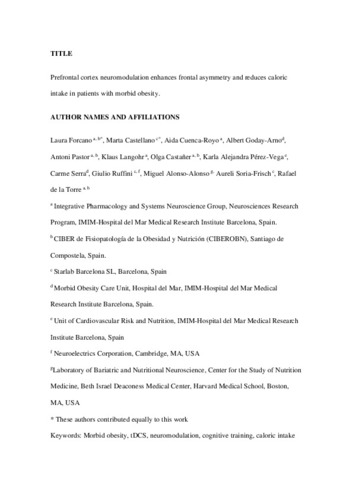Mostra el registre d'ítem simple
Prefrontal cortex neuromodulation enhances frontal asymmetry and reduces caloric intake in patients with morbid obesity
| dc.contributor.author | Forcano, Laura |
| dc.contributor.author | Cuenca, Aida |
| dc.contributor.author | Pastor, Antoni |
| dc.contributor.author | Langohr, Klaus |
| dc.contributor.author | De la Torre Fornell, Rafael |
| dc.contributor.other | Universitat Politècnica de Catalunya. Departament d'Estadística i Investigació Operativa |
| dc.date.accessioned | 2021-05-04T09:16:28Z |
| dc.date.available | 2021-05-04T09:16:28Z |
| dc.date.issued | 2020-04 |
| dc.identifier.citation | Forcano, L. [et al.]. Prefrontal cortex neuromodulation enhances frontal asymmetry and reduces caloric intake in patients with morbid obesity. "Obesity", Abril 2020, vol. 28, núm. 4, p. 696-705. |
| dc.identifier.issn | 1930-7381 |
| dc.identifier.uri | http://hdl.handle.net/2117/345038 |
| dc.description.abstract | Objective The objective of this study was to test the feasibility of a combined intervention involving transcranial direct current stimulation (tDCS) on the dorsolateral prefrontal cortex (dlPFC) and cognitive training (CT). Short-term effects on food consumption, cognition, endocannabinoid (eCB) levels, and electroencephalogram (EEG) markers of future weight loss were explored. Methods Eighteen healthy volunteers with morbid obesity were randomized in a double-blind, placebo-controlled, parallel trial. Participants received sham or active tDCS plus CT for four consecutive days. Cognitive performance, daily food intake, and eCB blood samples were collected before and after the intervention; EEG data were gathered before and after daily training. Results The active tDCS¿+¿CT group reversed left-dominant frontal asymmetry and increased frontal coherence (FC) in the ¿-band (30-45 Hz) after the intervention. The strength of the latter predicted BMI reduction. Additionally, a large intervention effect on food intake was shown in the active tDCS¿+¿CT group at follow-up (-339.6¿±¿639 kcal on average), and there was a decrease of plasma eCB concentrations. Conclusions dlPFC modulation through tDCS¿+¿CT is an effective tool to restore right dominance of the dlPFC and enhance FC in patients with morbid obesity. Moreover, the effect of the strength of FC on BMI suggests that the interhemispheric FC at the dlPFC is functionally relevant for the efficient regulation of food choice. |
| dc.format.extent | 10 p. |
| dc.language.iso | eng |
| dc.rights | Attribution-NonCommercial-NoDerivs 3.0 Spain |
| dc.rights.uri | http://creativecommons.org/licenses/by-nc-nd/3.0/es/ |
| dc.subject | Àrees temàtiques de la UPC::Matemàtiques i estadística |
| dc.subject.other | Morbid obesity |
| dc.subject.other | tDCS |
| dc.subject.other | Neuromodulation |
| dc.subject.other | Cognitive training |
| dc.subject.other | Caloric intake |
| dc.title | Prefrontal cortex neuromodulation enhances frontal asymmetry and reduces caloric intake in patients with morbid obesity |
| dc.type | Article |
| dc.contributor.group | Universitat Politècnica de Catalunya. GRBIO - Grup de Recerca en Bioestadística i Bioinformàtica |
| dc.identifier.doi | 10.1002/oby.22745 |
| dc.description.peerreviewed | Peer Reviewed |
| dc.subject.ams | Classificació AMS::90 Operations research, mathematical programming |
| dc.relation.publisherversion | https://onlinelibrary.wiley.com/doi/abs/10.1002/oby.22745 |
| dc.rights.access | Open Access |
| local.identifier.drac | 30604851 |
| dc.description.version | Postprint (published version) |
| local.citation.author | Forcano, L.; Cuenca, A.; Pastor, A.; Langohr, K.; De la Torre, R. |
| local.citation.publicationName | Obesity |
| local.citation.volume | 28 |
| local.citation.number | 4 |
| local.citation.startingPage | 696 |
| local.citation.endingPage | 705 |
| dc.description.authorship | Article signat per 13 autors/es: Laura Forcano, Marta Castellano, Aida Cuenca‐Royo, Albert Goday‐Arno, Antoni Pastor, Klaus Langohr, Olga Castañer, Karla Alejandra Pérez‐Vega, Carme Serra, Giulio Ruffini, Miguel Alonso‐Alonso, Aureli Soria‐Frisch, Rafael de la Torre |
Fitxers d'aquest items
Aquest ítem apareix a les col·leccions següents
-
Articles de revista [214]
-
Articles de revista [719]


